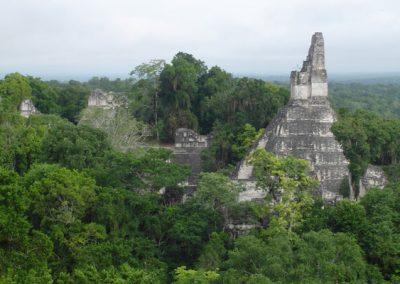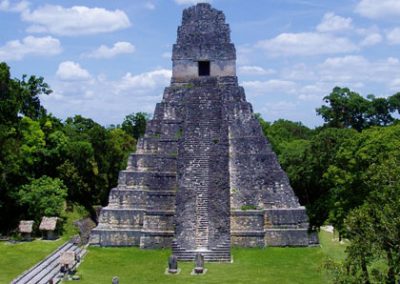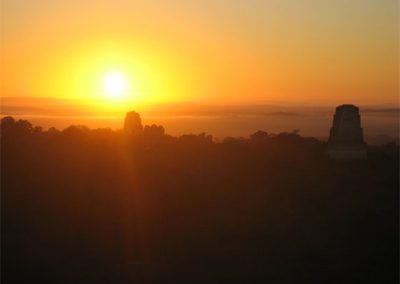
Key Facts
- Tikal National Park is located within the 6,000 square mile Maya Biosphere Reserve in the northern part of Petén, Guatemala
- Park area: 576 km² (222 miles², 125,000 acres²)
- The ruins area encompasses about 24 sq. kms. About 80% are still unexcavated.
- Only 30% of the ruins area has been mapped (around 6 miles²)
- Tikal was declared a National Park by the Guatemalan Government in May of 1955, and a National Monument in 1970. It was the first National Park established in Central America.
- The name ‘Tikal’ means ‘Place of Voices’ or ‘Place of Tongues’ in Maya.
Tikal National Park Travel Guide
Tikal National Park is located in Central America, in the Northern Guatemala department of Petén, 60 km from Petén’s capital city of Flores. There is no Tikal village or town.
There is no electricity in Tikal. Most buildings have generators running all day or a few hours for services.
The main arrival area includes the Visitor’s Center, two museums, a post office, Park Administration offices, souvenir and handcraft shops, three hotels, a campground, and a few restaurants and ‘comedores’. There is no ATM or bank in Tikal, the closest one is in El Remate.
The Visitor’s Center, open from 6am to 6pm, is located just before entering the trails that lead to the ruins, which are approx. 20min walking distance. Located at the Visitor’s Center entrance is a large model of Tikal, the way it would have looked when inhabited. Here you will also find one of the two museums, consisting of carved stone monuments and photos taken during the restoration in the 1960s. Also, there is a guide booth, information desk, souvenir shops and a restaurant.
A smaller museum housing some Tikal artifacts is well worth a visit, located a few hundred meters away, near the hotel area. A small fee is charged to enter (in addition to the park entrance fee).
Access to the ruins is by foot only. All cars must remain in the main parking area. If you require disabled assistance, you can get special permits at the park headquarters.
History
At its height, during the Classic period around 500AD, Tikal had a population of 50,000 to 100,000 people. Many consider it the main governing city of the Maya civilization. For reasons not yet clear, around 870AD the city’s decline began, and was completely deserted by the end of 900AD.
Tikal has an estimated 3,000 structures including temples, palaces, shrines, ceremonial platforms, residences, ball courts, terraces, causeways, and plazas, most interconnected with aqueducts
and cisterns for holding water. In the main ceremonial precincts there are around 200 stone monuments, known as stelae. Stelae are elaborately carved with glyphs, a form of writing, and other
images that tell stories about the rulers during that time. The partially restored area of Tikal consists of nine groups of courts and plazas. There are 5 large temples: Temple I or Temple of the
Great Jaguar, standing at around 44 m (144 ft), Temple II or Temple of the Masks, 37 m (120 ft), Temple III or Temple of the Jaguar Priest, 60 m (180 ft), Temple IV or Temple of the Double Headed
Serpent, 70 m (230 ft), and Temple V at 59 m (190 ft).
Since rediscovering Tikal in the late 1800s, archaeologists from all over the world have been excavating the site. Some structures are almost fully restored but the vast majority are high mounds with stones and lush growth of trees and vegetation. After the Maya abandoned Tikal, the city was reclaimed by the jungle. Even today it is only with a great deal of diligence that the restored ruins are not overgrown with trees and jungle vegetation. The park is rich with
tropical plants and wildlife. Tikal is truly a sanctuary for flora and fauna covering more than 200 square miles. Over 285 species of exotic birds, monkeys, jaguars, pumas, tapirs, small deer, and more rare and endangered wildlife inhabit here. Hundreds of orchid species and more than 30 hardwood species can be found.
Trees include the Chico Zapote, from which chicle, a base for chewing gum is derived, Spanish Cedar and the Ceiba, a tree sacred to the Maya. Tikal is no doubt a birdwatcher’s paradise, one of the best birding areas of Central America.
The most viewed (and heard) animals in Tikal are the Spider Monkey, Howler Monkey, Agouti, Coatimundi, Red-fronted Parrot, Keel-billed Toucan and Ocellated Turkey. Jaguars are rarely seen. You will not see Macaws or the Resplendent Quetzal (national bird of Guatemala).
Money & Schedule
The park boundary and main entrance is located 16 km before the parking area and Visitors Center. Tikal has an entrance fee of Q150.00 or around US$20.00 (at time of writing). Be sure to have Quetzales cash on hand, as the park does not accept foreign currency or credit cards.
Regular park hours are 6am to 6pm everyday, with the option to be in the park during extended hours for an extra fee. See below, Sunrise and Sunset in Tikal
Cost to enter the small museum near the hotels is approximately Q20, cash only accepted.
Please note that there’s no bank or ATM in Tikal, the closest is in El Remate. Credit cards are not accepted to pay your entrance fee to the park or museums. Some of the hotels, restaurants
or gift shops do accept credit cards, best to ask in advance.
Transportation to/from Tikal
Minibuses service the Tikal-Flores route everyday, and all must pass through El Remate. There are several types of shuttle buses that go to and from Tikal every 30 min. to 1 hour or so. Some are older collective local shuttles, often crowded with people who live on the route and/or others visiting the park, making several stops.
Other shuttles cater only to tourism, aren’t as crowded and are more direct. Wait anywhere along the main road and flag down one of these shuttles, if it’s available it will stop. Always ask the price before boarding, and it’s best to have exact change.
Most hotels in El Remate or Flores sell tickets for certain shuttles and book taxi service, especially for the early morning hours. From El Remate, there is a shuttle that leaves at 5:30am and returns at 2pm. Private transportation is also available, where you can set your departure and return time.
When booking transportation in advance, always ask about vehicle type and condition, age, A/C, capacity, etc. Overloading or improper maintenance of vehicles can be a common practice.
The services arranged by La Casa De Don David are what we feel to be the most satisfactory available and fit the needs of our guests.
Tips to help you get the most of your day in Tikal:
- If you’re only visiting for one day, plan on just hitting the main spots, such as the Main Plaza, Temple IV, Temple V and Mundo Perdido. You can easily spend two days to a week or more at the park and not see every ruin that has been excavated.
- Wear sensible shoes. There is plenty of walking.
- Try to climb at least one of the temples, especially Temple IV. This is where you will get the best view.
- It’s best to pack a lunch, or at least some snacks. There is no food sold within the ruins area, which is a 20 min walk from the restaurants. Beverages and basic snacks are available in the park.
- Have insect repellent on hand. The jungle around the ruins is dense and mosquitoes can be a problem.
- The earlier you can get to the ruins, the better. Dawn is the best time to see birds and animals. Temple IV is the most popular early morning spot. This is the place to get the ‘special photo’ of temples III, II and I rising up through the jungle, with the sun rising in the background. But beware, it is common to find heavy fog in the area, which still can make for a special photo.
- Don’t miss seeing the large mask in the North Acropolis in the Main Plaza. It is covered by a small thatched roof.
- Wildlife is abundant in the park. Walk slowly, keep your voice low and listen. If you hear or see small fruits and branches falling, look up and you will usually see monkeys or birds.
- Upon exiting to the parking area, visit the small museum near the hotels. Cost is Q20 and is worth it. The Visitors Center has a free museum which mostly has stelae and restoration photos.
Things to bring:
- Camera and extra batteries
- Hat and sun protection
- Mosquito repellent
- Map (if you have one, but not necessary)
- Identification (copy of passport is sufficient)
- Rain protection
- Binoculars
- Flashlight to look in some dark rooms
- Mobile phone (signal can be found on top of some temples)
- Quetzales cash
Sunrise and Sunset in Tikal

Sunrise
A very special experience, visitors sit atop Temple IV to watch the sunrise, the early morning mist rising from the pyramids and the jungle ‘waking up’. The park administration reinstated permission in 2012 to access the park before normal operating hours of 6am-6pm. Visitors can now enter the park from 4am for sunrise or stay in the park for sunset until 8pm, for Q100pp (around US$13) in addition to the normal entrance fee of Q150. During these extra hours visitors must be accompanied by a guide. It can be difficult to get a good clear sunrise as the jungle is often covered in dense fog. This can be a special sight in itself, as well as walking through the park in the dark.
Sunset
Some visitors opt for spending the sunset hours in Tikal, staying in the park for extended hours of 6-8pm. However keep in mind that Temple IV as well as other main temples face East and the back sides are not always accessible to the public. The Mundo Perdido pyramid is often chosen for viewing the sunset, at your time of visit your guide will try to find the best viewing spot.
A great alternative for sunset visits is Yaxha, please see Tours and Activities
Guides in Tikal
You can find a licensed guide from around $50 for 1-5 persons, $8-10 per extra person, up to $100 maximum charge. If you join a group, you may pay as little as $6-8 per person. Be aware that there is not much price or group capacity control, some guides have been known to guide more than 50 persons. It’s best to be with a group of no more than 15 persons.
If you are on a bus to Tikal or upon arrival to the park encounter a guide offering his service, be sure to ask for his CARNET or INGUAT (Guatemala Institute of Tourism) license. Regulations passed in 2009 require all guides in Tikal to be licensed.
You can book a guide from La Casa De Don David. Alternatively, you can visit the guide booth in the Tikal Visitors Center upon your arrival. Ask for details such as languages spoken and experience. We don’t advise buying services on the street.



